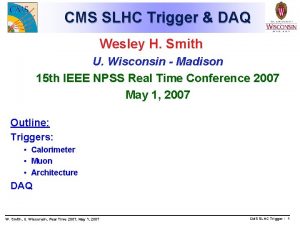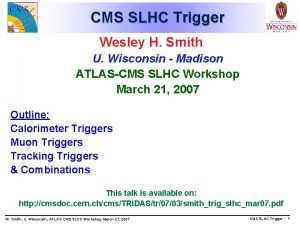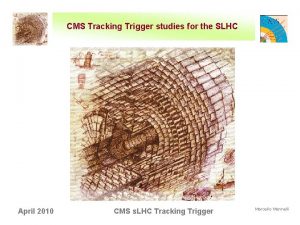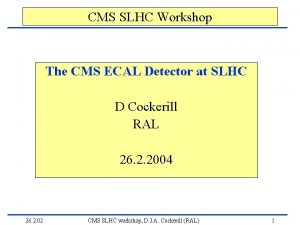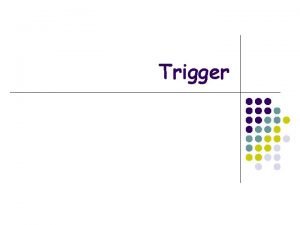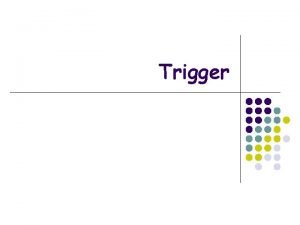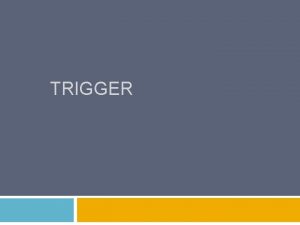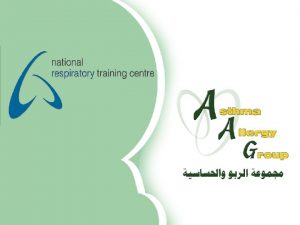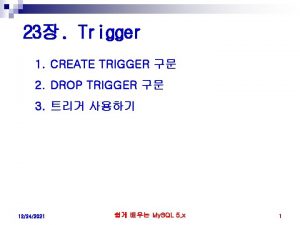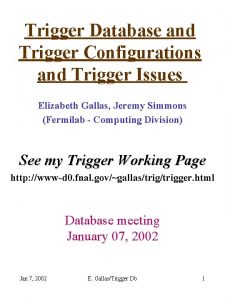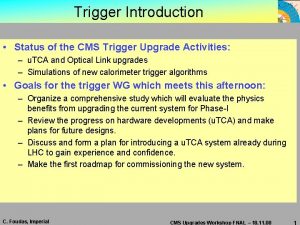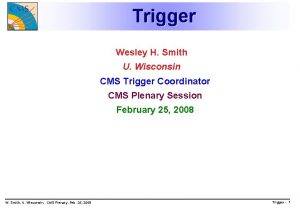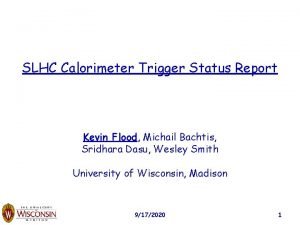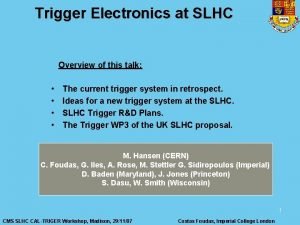Trigger RD for CMS at SLHC Part 1




















- Slides: 20

Trigger R&D for CMS at SLHC: Part 1 An evolving trigger architecture. . . 23 Sept 2009 Trigger Development for SLHC 1

Hadron Calorimeter Electromagnetic Calorimeter RCT GCT Trigger 23 Sept 2009 Trigger Development for SLHC 2

Trigger Requirements – Task • Build physics objects – cluster electrons, taus, jets – calculate quantities such as total-et • Sort in order of rank • Identify physics topologies – Must not miss interesting events – Can be crude: just a trigger! Build physics objects Sort in order of importance Interesting event ? • Latency must be short – Questions • How best to map task onto physical geometry? • What type of hardware architecture • What services required? 23 Sept 2009 Trigger Development for SLHC 3

Geometry of RCT Neg Eta 0 Electron or Tau Jet x 18 Tower Phi Non Tau Jet 1 2 Pos Eta Region 3 4 5 6 7 8 9 10 Region Number / Eta Index Constant phi strip Phi Barrel Endcaps Data per tower, per bx ECAL: 8 bits energy + FGV (Fine. Grain. Veto) HCAL: 8 bits energy + MIP (Min. Ionising. Particle) 23 Sept 2009 Trigger Development for SLHC 4

Geometry & link capacity B B Region B B B E E E HF FF HF HF HF – Number of Regions: 22 (eta) x 18 (phi) – 1 Region = 4 x 4 Towers Tower – 1 Link at 4. 8 Gb/s (8 B/10 B) • 12 bytes per bx • Hence 1 region = 2 links (12 bits) – 4 links per region for both ECAL & HCAL data. 23 Sept 2009 Trigger Development for SLHC 5

Plan A: Original Plan – Apply all jet + electron clustering in single FPGA Region Tower – To contain jet centred on middle region requires 3 x 3 regions • i. e. 36 links at 5 Gb/s – 14 x 18 regions (excluding HF) • More than 252 cards How best to achieve such large duplication of data ? 23 Sept 2009 Trigger Development for SLHC 6

Technology – Use large protocol agnostic crosspoint switches (~100 x 100) to duplicate data and route it to where required – u. TCA crate provides high density serial interconnect • Based on AMC cards (daughter cards used in ATCA) • 20 serdes links + ethernet • Compact form factor ideal for serdes links Optics 23 Sept 2009 Optics FPGA X-point Switch Trigger Development for SLHC Would require custom backplane to get many neighbour to neighbour connections 7

Matrix card – Developed as part of the GCT project • Design was conceived by Matt Stettler from LANL – John Jones will describe it in more detail in a following talk that will describe “Plan C” 16 Optics FPGA 16 6/12 Tx Chans not fully operational 23 Sept 2009 Trigger Development for SLHC X-point Switch 20 8

23 Sept 2009 MCH 2: LHC-CLK, TTC & TTS and DAQ Concentrator MCH 1 PM 2 Vadatech VT 891 12 Full width AMC slots MCH 1 providing Gb. E and standard functionality Trigger Development for SLHC 9

Plan A: Issues – Matrix card very novel concept, but doesn’t have enough links to realise the original vision. . – Original plan does have some drawbacks. . . • Large system of > 252 identical cards • Requires 2 stage sort with resulting latency penalty • Very inefficient • Serdes signal making too many hops without regeneration Is there an alternative approach? • 20 serdes links on backplane insufficient 23 Sept 2009 Trigger Development for SLHC 10

Plan B: Fine Processing – Concentrate on electron and tau jet processing initially • Small area – typically < 2 x 2 towers – Allow capability to explore different algorithms • Could use existing algorithms – “Calorimeter Trigger for Phase I”, M. Bachtis et al. , Wisconsin • or Pre-cluster method used in GCT x 4 Ser. Des / QSFP 23 Sept 2009 Clustering process Trigger Development for SLHC 11

Plan B: Coarse Processing – For jets reduce resolution by factor of 2 • Perfectly adequate • Nicely matches HF resolution + Clustering process 23 Sept 2009 Trigger Development for SLHC 12

Plan B Card – No need for a custom backplane, • although one could be used to either provide additional bandwidth or to reduce optical components. – Only uses ~100 cards => single stage sort – Substantially simpler to connect • Single QSFP cable between cards. Can span crates – The compromise is a a less flexible algorithm • i. e. electron/jet processing separated 24 12 4 Optics 4 FPGA 23 Sept 2009 24 12 4 Optics 4 FPGA 24 4 Optics 4 Trigger Development for SLHC FPGA 4 13

MINI-T 5 2 x 40 Diff Pairs at 1. 25 Gb/s Low latency interface Atmel AT 32 UC 3 A 8 Backplane (LVDS option) 2 x QSFP 4 Bi. Dir 5. 0 Gb/s 2 x SNAP 12 -OUT 12 x 5. 0 Gb/s Xilinx XC 5 VLXT 150 T 2 x SNAP 12 -IN 12 x 5. 0 Gb/s 23 Sept 2009 Trigger Development for SLHC Manufacture September 14

Plan B: System view (u. TCA crates) Electron Cluster Reg -6 to -3, Phi 0 -8 Electron Cluster Reg +0 to +2, Phi 0 -8 Electron Cluster Reg +3 to +6, Phi 0 -8 Electron Cluster Reg -6 to -3, Phi 9 -15 Electron Cluster Reg +0 to +2, Phi 9 -15 Electron Cluster Reg +3 to +6, Phi 9 -15 HF HF Jet Cluster Neg Eta 9 cards Latency dominated by number of links Keep number of layers to a minimum Jet Cluster Pos Eta 9 cards Elec and Jet Sort Elec: 4 cards, Jet: 2 cards 16 Iso. Elec 16 Non. Iso. Elec, 16 Tau. Jets, 8 Forward. Jets, 8 Central. Jets, Total/Missing Et/Ht, Etc Global Trigger 23 Sept 2009 Trigger Development for SLHC 15

Trigger R&D for CMS at SLHC: Part 2 Analysis of failing high speed serial links on the Matrix Card 23 Sept 2009 Trigger Development for SLHC 16

- Hard to debug => Lot of conjecture. - Initial hypothesis completely wrong in all cases 23 Sept 2009 Test board to access SNAP 12/POP 4 signals Trigger Development for SLHC 17

Link running at 2. 5 Gb/s - Infiniband Tx mask Assumed CDR PLL has cut-off at ~ 1000 bit periods (2. 5 MHz) Fits perfect theoretical clk to data, then extracts “eye” Can correlate mask failure with position on data stream Only possible on real time scope. . . 23 Sept 2009 Trigger Development for SLHC 18

Scope can store second channel while in SDA (Serial Data Analysis Mode) Allows correlation between SDA events and other signals on the PCB – At 200 MHz Interplane impedance is ~0. 4 Ohm • Simple parallel plate model – At 200 MHz capacitors behaving like inductors • Impedance > 1 ohm ~ 200 MHz noise, 100 m. V pk to pk 23 Sept 2009 Trigger Development for SLHC 19

Conclusions: -- Upgrade to trigger already started: Optical interface from GCT to GT running at 3. 0 Gb/s with async ref clks. -- Already have knowledge, or are rapidly gaining it in key technologies (e. g. firmware for low latency high speed serial links, u. TCA and PCB design) -- Many novel ideas within the trigger group on how best to build a powerful, yet flexible trigger architecture. 23 Sept 2009 Trigger Development for SLHC 20
 Novosirisk
Novosirisk Delegerande ledarstil
Delegerande ledarstil Matematisk modellering eksempel
Matematisk modellering eksempel Cks
Cks Personalliggare bygg undantag
Personalliggare bygg undantag Vishnuiter
Vishnuiter Kyssande vind analys
Kyssande vind analys Inköpsprocessen steg för steg
Inköpsprocessen steg för steg Kolopskopi
Kolopskopi Strategi för svensk viltförvaltning
Strategi för svensk viltförvaltning Standardavvikelse
Standardavvikelse Datorkunskap för nybörjare
Datorkunskap för nybörjare Tack för att ni har lyssnat
Tack för att ni har lyssnat Läkarutlåtande för livränta
Läkarutlåtande för livränta Treserva lathund
Treserva lathund Returpilarna
Returpilarna Påbyggnader för flakfordon
Påbyggnader för flakfordon Tack för att ni lyssnade
Tack för att ni lyssnade Tobinskatten för och nackdelar
Tobinskatten för och nackdelar Egg för emanuel
Egg för emanuel Tack för att ni har lyssnat
Tack för att ni har lyssnat























